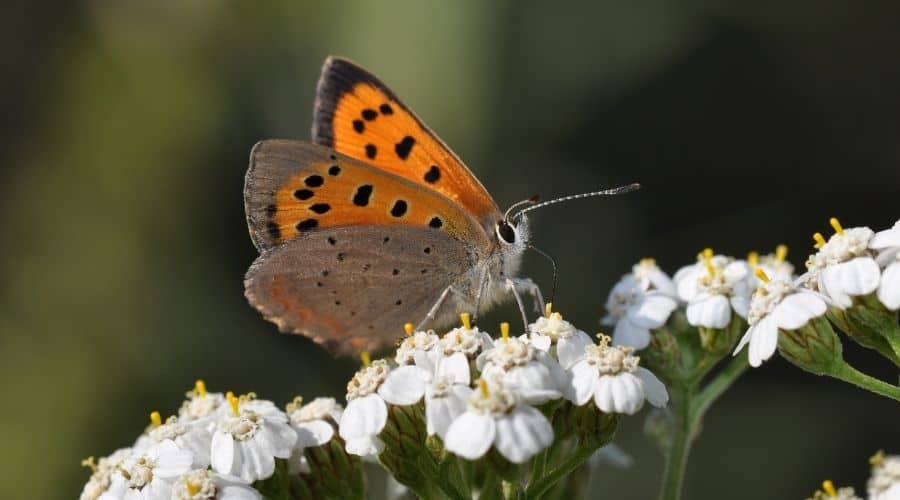Butterflies eat lots of things like nectar, tears, urine, mud, sweat, and perhaps most disturbing of all, feces. However, ‘eat’ isn’t the proper term for it since it implies a mouth and jaw that chew, but they technically only drink liquids.
In fact, butterflies can release a liquid they create to ensure the nutrients in their food are dissolved and digestible. Do butterflies have teeth?
Butterflies do not have teeth because they have no mouth or jaw to bite or chew with. Since butterflies don’t eat solid foods, they use a straw-like tube called a proboscis to slurp meals like nectar for their sugar, salt and other nutrients. Butterflies don’t taste their food with their proboscis, instead they use their feet and legs when they land on a surface.
Table of Contents
How Many Teeth Do Butterflies Have
Butterflies don’t have any teeth at all. If that’s not odd enough, they also lack the ability to taste their food with their proboscis.
All of a butterfly’s ability to taste comes from their feet and legs when they land on a surface, so if a butterfly lands on you, it is actually tasting your skin or clothing.
Teeth are commonly mistaken for bones, but they are different. Although both bones and teeth are a repository for calcium, they don’t have much else in common.
According to Dr. Koumas, “Teeth are made out of enamel, which might be a familiar term to you. Enamel is the outer layer of your tooth, the visible part and is responsible for protecting your teeth. The other tissues that your teeth are made up of are dentin, cementum and pulp. Teeth are the hardest parts of our bodies because of the enamel which consists of calcium phosphate.”
Butterflies don’t have bones, dentin, cementum, or tooth pulp in any part of their body. Like all insects, they do have an exoskeleton, but it’s made of chitin, and it certainly has no teeth.
This rigid outer shell protects their internal organs but doesn’t help them chew or bite.
Why Butterflies Don’t Have Teeth
Butterflies don’t eat solid foods. Most of their energy needs are easily met by sipping sweet nectar constantly from flowers. However, even a butterfly needs more than sugar to survive.
What the insects can’t get from the blooms is readily available from other creatures or sometimes present in the soil.
When a butterfly needs nutrients or salts, it can’t drink from nectar; it engages in puddling. This practice is named after the literal puddles of mud that often provide minerals and natural salt.
Alternatively, caterpillars, the larval stage of butterflies, do have chewing mouthparts. Having teeth is the most biologically simple solution since they need to bite and grind up massive quantities of tough fibrous leaves very quickly to grow.
Once they pupate and metamorphose, the butterfly’s mouth changes into the proboscis, and the old parts dissolve away.
Do Butterfly Need Teeth
After they hatch, newborn baby butterflies, known as caterpillars, need teeth. However, there’s no part of their adult life when teeth would benefit butterflies.
Their defense mechanisms don’t involve biting, but more importantly, they need the sugars from nectar because of their high metabolism and constant movement.
How Butterflies Eat Without Teeth
Butterflies don’t ‘eat’ anything. Instead, they drink all their meals, whether it’s sugary nectar or salt, and minerals from puddling in mud, feces, and urine, or even sipping the tears of turtles.
Most of the time, butterflies carry their drinking instrument curled up and out of the way, only extending it when they plan to have a meal.
As Save Our Monarchs puts it, “A proboscis is basically an elongated snout that can straighten by hydrostatic pressure, allowing them to drink the nectar from tube-like flowers. When they aren’t feeding, their proboscis is rolled up on the underside of their head.”
If the food the butterfly needs isn’t wet enough to drink, they can fix that issue. By excreting a fluid from their digestive tract, they add moisture and dissolve the nutrients and salts they can’t get from flowers.
Do Monarch Butterflies Have Teeth
Monarch butterflies are like all the Lepidoptera or butterfly and moth family members. They eat through a proboscis and have neither teeth nor a beak.
Although these butterflies are unique because they are among very few that can eat poisonous plants, they are still essentially like other members of their family with 4 wings, a chitinous body, 2 antennae, 6 legs, and a proboscis.
Can A Butterfly Bite You
A butterfly cannot bite you. They also cannot sting you since they don’t possess a stinger. As sharp as some proboscises look, they aren’t made for stabbing like a needle.
There are very few ways a butterfly could ever harm a human.
Some butterflies are toxic, like the monarch that eats milkweed, so it could make you sick to your stomach if you ate it.
Ultimately, you’d most likely need to eat several to get seriously ill. Butterflies aren’t aggressive at all, and they typically only defend themselves by fluttering around and generally being hard to catch or looking dangerous.
The bright wing colors tell predators that butterflies are likely poisonous, and the eye markings can look like a larger animal, but these insects don’t have any real weapons.
Beyond that, the only other things that can make a butterfly dangerous are infections and parasites they can carry and pass on.
Helpful Tips To Know If Butterflies Have Teeth
Butterflies use their proboscis to eat instead of teeth or a beak, as many creatures do. The unique method of gathering meals means they can only swallow what they pull through the appendage in liquid form.
Here are a few more helpful tips to know if butterflies have teeth.
- In addition to feces, sweat, tears, and urine, butterflies will sometimes drink blood. It sounds sinister, but they need the salt and minerals, and they aren’t picky about how they obtain it.
- Caterpillars have mandibles like many other insects. Both carnivorous and herbivorous bugs use these unique tooth-like pincers to eat.
- Because their larval stage has a form of teeth, but their adult form does not, butterflies are one of the only insects in the world that both have and do not have teeth. However, since only the adults are called butterflies, it’s easier to simply say that they use a proboscis instead of a beak or mouth.
Final Thoughts
A butterfly with teeth would be very dangerous and utterly creepy despite its lovely colors. In nature, all animals and insects have bodies that are made for their particular survival strategies.
Butterflies need their proboscis and light, high metabolism frames to be pollinators. Even if a butterfly could produce the necessary enamel and calcium to make teeth for its head, the trade-off would be weight from the minerals, and that would make it harder to fly.
Furthermore, considering that butterflies will drink blood for the salt, it’s fortunate for us that they never evolved that particular feature.

